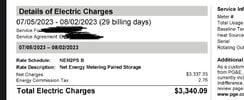I’m still trying to figure out what’s going on…
A month or so ago they dropped a ~$1700 credit, also outta nowhere. Then last night the paired storage nem charge of -$3400. So we have a bill of ~$1700.
This is NOT the annual true up.
Anyone experience else experience this? No recourse or way to question the charge?
My setup:
5.5 kW non-tesla PV system -2015
6.0 kW tesla PV system 2022
Both systems feed:
Dual PowerWalls 2022
A month or so ago they dropped a ~$1700 credit, also outta nowhere. Then last night the paired storage nem charge of -$3400. So we have a bill of ~$1700.
This is NOT the annual true up.
Anyone experience else experience this? No recourse or way to question the charge?
My setup:
5.5 kW non-tesla PV system -2015
6.0 kW tesla PV system 2022
Both systems feed:
Dual PowerWalls 2022



